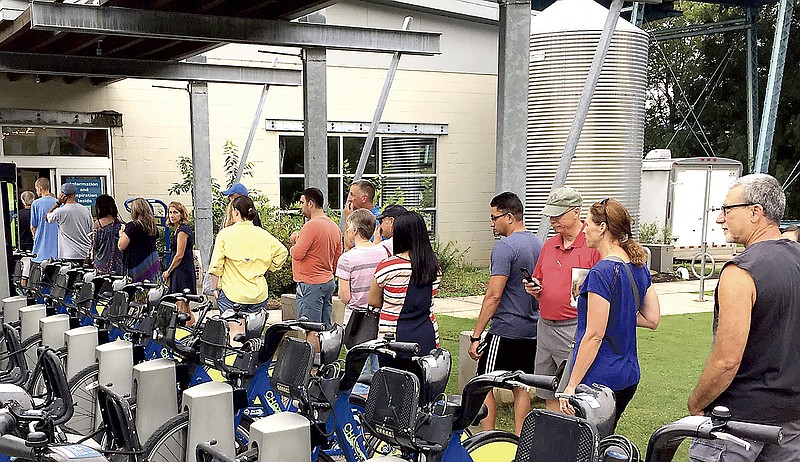"The mind wants to live forever, or to learn a very good reason why not."
Charlie Steinhice, a 57-year-old manager at BlueCross BlueShield, thinks those who shrug off Monday's solar eclipse are making the mistake of a lifetime.
After hearing his story, it's hard to argue.
Steinhice has been there. He has experienced the thrill of the moon blocking the sun and unmasking the stars in the middle of the day. At age 19 in 1979, Steinhice - then a University of Tennessee at Chattanooga student - traveled to Williston, N.D., to witness the most recent total solar eclipse in the contiguous United States.
He rode from Chattanooga to North Dakota with a friend in a 1972 Chevrolet Impala sedan named "Fancy." People probably thought they were crazy driving to North Dakota in the middle of winter, but for Steinhice the trip was a journey of self-discovery.
"I was not a risk taker," Steinhice remembers. "My Dad had died of pancreatic cancer. I was living in a friend's basement. I was pretty down."
A couple of years earlier, Steinhice had befriended a park ranger at Russell Cave National Monument in Bridgeport, Ala. The ranger, Dave Hannah, eventually moved to North Dakota to take another assignment with the National Park Service. In late 1978, he wrote a letter to Steinhice and a few other friends from Southeast Tennessee urging them to drive out and visit him for the big eclipse.
View other columns by Mark Kennedy
In 1979, Steinhice calculated that he would be "really old" when the next major eclipse event happened in 2017. He would, in fact, be 57 years old - the same age his father had been when he died of cancer. Life offered no guarantees, Steinhice knew. He might not even be alive for the next total eclipse.
So, Steinhice and his buddy Bob Selcer decided to pool their money and drive three days for a celestial event that would last less than three minutes. Along the way, Steinhice checked off states toward his goal of visiting all 50 before he died.
The "path of totality" in 1979 passed through Oregon, Washington, Idaho, Montana and a portion of North Dakota. Steinhice and his crew positioned themselves on a hillside near Williston in a group of perhaps 40 eclipse watchers. Among the crowd was a solar physicist with an improbable name, Dr. Steve Suess. There was also a reporter from The Associated Press who thought the eclipse assignment was a punishment from his editor.
In a stroke of luck, Steinhice and his group were positioned in a 40-mile break in the clouds that covered the northwestern United States that day. Fate had also put him on a mountain with Dr. Suess, who provided a running commentary as events unfolded.
Steinhice remembers the eclipse this way:
"Conditions were perfect. In the 10 minutes before the eclipse we could see these shadow bands - strips of light and shadow. Just an instant or two before totality you have what's called the diamond ring effect. You have the full ring of the sunlight around the moon, and one spot that is not occluded lasts very briefly [like a diamond]. And it's beautiful."
At the moment of totality, Steinhice remembers the crowd turned exuberant.
"We were all whooping and cheering," he recalls.
At that moment, Steinhice remembers glancing over to a nearby freeway, U.S. Highway 2, and being struck by the number of drivers who seemed to be ignoring the thrilling spectacle in the sky.
"Almost all of the cars on the highway just turned on their headlights and kept driving," he remembers. "It's 11 in the morning and the sun just went out. How do you not stop and see it? How do you ignore something like that? How do you take it for granted?"
Later that day, Steinhice made a vow to himself.
"I said at the time, 'I will never be one of those people. I am going to pay attention. I am going to seek out experiences.'"
True to his word, Steinhice eventually took the atlas he used to navigate to North Dakota and doubled down on his desire to visit all 50 states. In time, he would decide to visit not just every state, but every county in the United States - all 3,142 of them. So far he has checked off about 2,400, or about 76 percent of his goal.
More than just a numerical chase, it is the backbone of his plan - formulated after the 1979 eclipse - to "seek out experiences." Experiences like visiting a leper colony in Hawaii, drinking a milkshake made from Betty's Pies in Two Harbors, Minn., and visiting a memorial to Notre Dame football star George "The Gipper" Gipp in Calumet Township, Mich.
Steinhice says Monday's solar eclipse will feel like a "homecoming," and he has friends coming from around the country to Southeast Tennessee to watch the sky with him.
At the moment of totality, Steinhice will again be whooping and cheering.
First, for a mid-life encore of the moon's show-stopping magic trick.
And second, in celebration of a life well lived.
Contact Mark Kennedy at mkennedy@timesfreepress.com or 423-757-6645.
